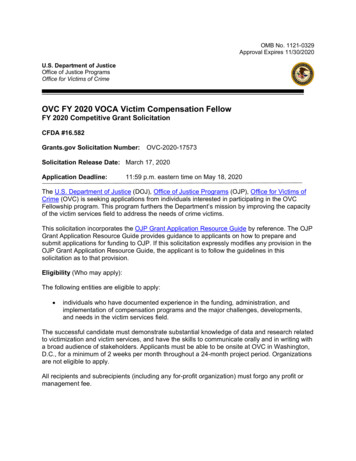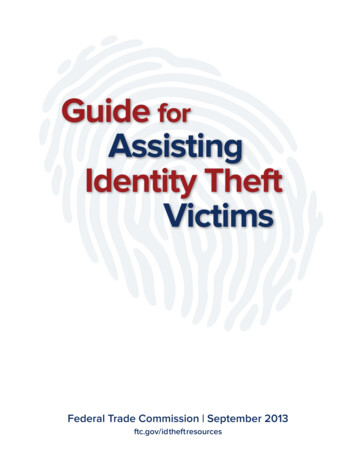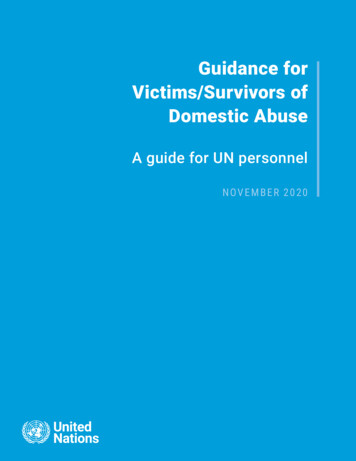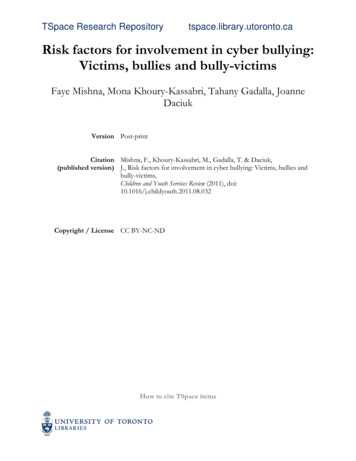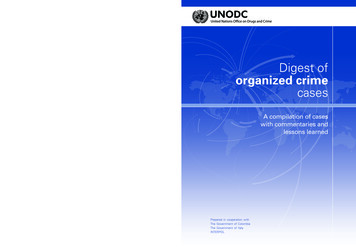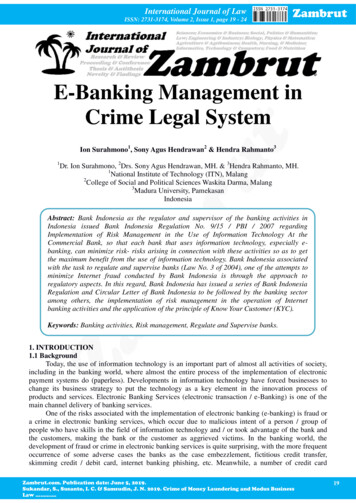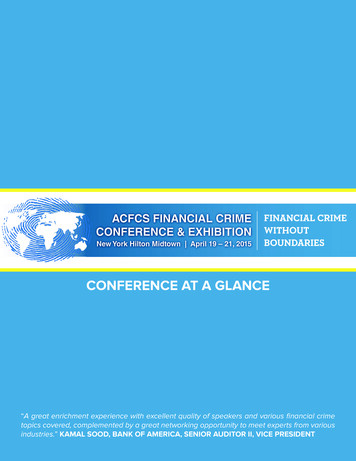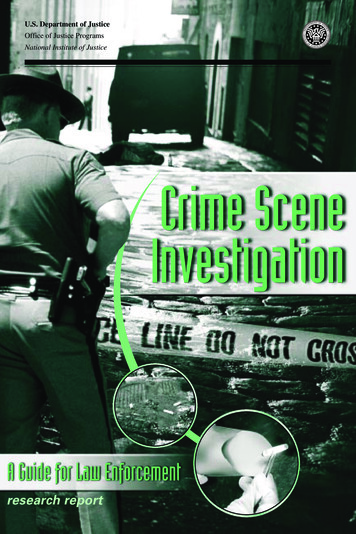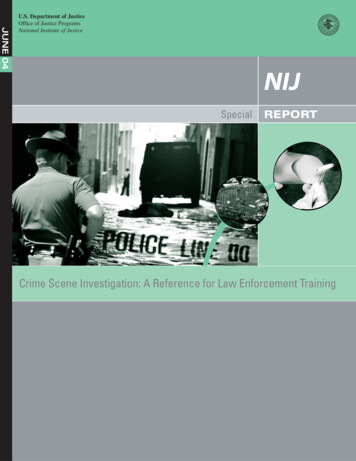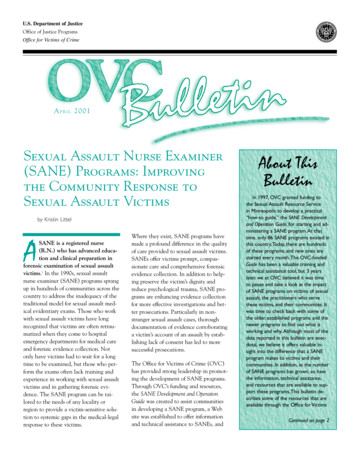
Transcription
U.S. Department of JusticeOffice of Justice ProgramsOffice for Victims of CrimeA P R I L 2 001Sexual Assault Nurse Examiner(SANE) Programs: Improvingthe Community Response toSexual Assault Victimsby Kristin LittelSANE is a registered nurse(R.N.) who has advanced education and clinical preparation inforensic examination of sexual assaultvictims.1 In the 1990s, sexual assaultnurse examiner (SANE) programs sprangup in hundreds of communities across thecountry to address the inadequacy of thetraditional model for sexual assault medical evidentiary exams. Those who workwith sexual assault victims have longrecognized that victims are often retraumatized when they come to hospitalemergency departments for medical careand forensic evidence collection. Notonly have victims had to wait for a longtime to be examined, but those who perform the exams often lack training andexperience in working with sexual assaultvictims and in gathering forensic evidence. The SANE program can be tailored to the needs of any locality orregion to provide a victim-sensitive solution to systemic gaps in the medical-legalresponse to these victims.AWhere they exist, SANE programs havemade a profound difference in the qualityof care provided to sexual assault victims.SANEs offer victims prompt, compassionate care and comprehensive forensicevidence collection. In addition to helping preserve the victim’s dignity andreduce psychological trauma, SANE programs are enhancing evidence collectionfor more effective investigations and better prosecutions. Particularly in nonstranger sexual assault cases, thoroughdocumentation of evidence corroboratinga victim’s account of an assault by establishing lack of consent has led to moresuccessful prosecutions.The Office for Victims of Crime (OVC)has provided strong leadership in promoting the development of SANE programs.Through OVC’s funding and resources,the SANE Development and OperationGuide was created to assist communitiesin developing a SANE program, a Website was established to offer informationand technical assistance to SANEs, andAbout ThisBulletinIn 1997, OVC granted funding tothe Sexual Assault Resource Servicein Minneapolis to develop a practical“how-to guide,” the SANE Developmentand Operation Guide, for starting and administering a SANE program.At thattime, only 86 SANE programs existed inthis country.Today, there are hundredsof these programs, and new ones arestarted every month.The OVC-fundedGuide has been a valuable training andtechnical assistance tool, but 3 yearslater, we at OVC believed it was timeto pause and take a look at the impactof SANE programs on victims of sexualassault, the practitioners who servethese victims, and their communities. Itwas time to check back with some ofthe older, established programs and thenewer programs to find out what isworking and why. Although most of thedata reported in this bulletin are anecdotal, we believe it offers valuable insight into the difference that a SANEprogram makes to victims and theircommunities. In addition, as the numberof SANE programs has grown, so havethe information, technical assistance,and resources that are available to support these programs.This bulletin describes some of the resources that areavailable through the Office for VictimsContinued on page 2
OVC BulletinAbout This BulletinContinued from page 1programs address several problems in themedical-legal response to sexual assaultvictims in hospital emergency departments, including the following:of Crime and other public and professional organizations. Finally, with every success come newchallenges. How can a SANE programfind funding to sustain itself after its initial development? What is the role ofthe SANE within the framework of asexual assault response team (SART)?What is involved in establishing SANEstandards of practice, training, and certification? We believe the information andpromising practices presented in thisreport will assist programs and communities as they address these and manyother emerging issues.Emergency department staff frequently regard the needs of sexualassault victims as less urgent thanother patients because the majorityof these victims do not sustain severe physical injuries.3 Sexual assault victims often endurelong waits in busy public areas(4- to 10-hour waits are notuncommon). Sexual assault victims often are notallowed to eat, drink, or urinatewhile they wait for a physician ornurse to conduct the evidentiaryexam, to avoid destroying evidence. Physicians or nurses who performevidentiary exams often have notbeen trained in forensic evidencecollection procedures or do not perform these procedures frequentlyenough to maintain proficiency. Some physicians are reluctant toperform evidentiary exams becausethey know that they might be calledfrom the hospital to testify in courtand that their qualifications toconduct the exam might be questioned due to a lack of training andexperience.One of the global challenges that OVChas embraced is to support, improve,and replicate promising practices in victims’ rights and services. Our support ofSANE programs moves us, and the field,closer to the goal of ensuring that everyvictim receives fundamental justice andneeded services. In many ways, this bulletin is a salute to the field—to theSANEs and countless others in the victim advocacy, criminal justice, and medical fields who have embraced the SANEmodel and worked ceaselessly to bringSANE services to their communities.regional workshops about how to start aSANE program have been presented.This bulletin provides information, ideas,and resources that will encourage individuals and agencies nationwide to explore the possibility of starting a SANEprogram in their areas. Emergency department staff may notunderstand sexual assault victimization (e.g., they may blame victimsfor their assaults or may not believea “real rape” occurred) and overlookthe need to treat victims with sensitivity and respect. Emergency department staff may failto gather and/or document all available forensic evidence, particularlyin nonstranger cases.Victim Benefitsne advocate contended that theSANE program was “the best development in victim services” thatshe had seen “in the last 10 years.”2 SANEO2With the advent of SANE programs, itbecame possible for sexual assault victimsto consistently receive prompt and compassionate emergency care from medicalprofessionals who understand victimization issues (e.g., SANEs recognize thatthe majority of victims are assaulted byintimate partners or acquaintances). ASANE can speed up the evidentiary examination process by reducing the timevictims have to wait in a hospital’s emergency department and the time it takesto complete the examination.4 The quality of the examination is usually improvedbecause an experienced SANE is adept atidentifying physical trauma and psychological needs, ensuring that victims receive appropriate medical care, knowingwhat evidence to look for and how todocument injuries and other forensic evidence, and providing necessary referrals.Evidence collected by SANEs can helplink the victim and suspect to the crimescene, indicate sexual penetration or activity, and establish lack of victim consent (e.g., bumps on the back of thehead, abrasions on the back, and nongenital bruising). Establishing lack of consent is particularly important in theprosecution of nonstranger cases.Recognizing the horror of sexual assaultand the devastation it can cause victimsand their significant others, SANEs ultimately strive to ensure that victims arenot retraumatized by the evidentiaryexam and to facilitate the healing process.SANE Program Director Jamie Ferrell,with the Sexual Assault Prevention andCrisis Services Division of the TexasOffice of the Attorney General, remarked that “it’s incredible to work withvictims at possibly their lowest level offunctioning and see them walk awaywith their heads held high.’’5 SANECoordinator Suzanne Brown, at InovaFairfax Hospital in Fairfax, Virginia,noted that it was not uncommon forvictims and their families to express
SEXUAL ASSAULT NURSE EXAMINER (SANE) PROGRAMSgratitude to SANEs for the caring and efficient treatment they provided. On thefew cases she has worked where victims ofrepeat assaults had evidentiary exams performed at different times by non-SANEsand SANEs, the victims commented thatthey wished they had been treated by aSANE the first time.6SANE ProgramDevelopmenturses established the first SANEprograms in the mid- to late1970s, in Minneapolis, Minnesota;Memphis, Tennessee; and Amarillo,Texas. It was not until the late 1980s,however, that these programs came together with other groups to promote thisrole for nurses. By 1991, the Journal ofEmergency Nursing reported on the existence of 20 SANE programs. SANEprograms developed rapidly after themid-1990s, as localities learned about thebenefits SANEs offer. The Journal ofEmergency Nursing noted that 86 SANEprograms were known to exist by 1996.In 1997, the SANE Development andOperation Guide identified 116 programs.The Guide’s author, Linda Ledray, estimated that more than 300 programs hadbeen established by July 1999 and thatthe number is likely to expand muchmore rapidly in the years to come.7SANE programs that are not listed inthe Guide are urged to register on theSexual Assault Resource Service Website at www.sane-sart.com—the Guidecan be viewed through the Web site.NSANEs are forensic nurses; however,not all forensic nurses are trained to beSANEs. Forensic nurses also conduct evidentiary exams in cases involving othertypes of interpersonal violence, publichealth and safety, emergencies or trauma,patient care facilities, and police and corrections custody abuse.8 To support theirwork, SANEs and other forensic nurseshave worked to build networking opportunities and to encourage the field toofficially recognize the importance offorensic nursing. In 1992, representativesfrom 31 SANE programs from the UnitedStates and Canada met and founded theInternational Association of ForensicNurses (IAFN). IAFN is an internationalprofessional organization of registerednurses formed to develop, promote, anddisseminate information about the science of forensic nursing nationally andinternationally. The American NursesAssociation (ANA) recognized forensicnursing as a specialty area in 1995. Obtain information about the victim’s pertinent health history andthe crime. Assess psychological functioning sufficiently to determine whether thevictim is suicidal and is oriented toperson, place, and time. Perform a physical examination toinspect and evaluate the body of thevictim (not a routine physicalexam). Collect and preserve all evidenceand document findings. Collect urine and blood samplesand send them to designated laboratories for analysis in cases wheredrug-facilitated sexual assault issuspected.11 Treat and/or refer the victim formedical treatment (a SANE maytreat minor injuries such as minorcuts and abrasions, but further evaluation and care of serious trauma isreferred to a designated medical facility or physician). Provide the victim with prophylacticmedications for the prevention ofsexually transmitted diseases (STDs)and other care needed as a result ofthe crime. Provide the victim with referrals formedical and psychological care andsupport.Program Operationhile SANE programs may operatedifferently depending on factorssuch as community-specific coordinated response protocols and SANEprogram location, their primary functionis to provide objective forensic evaluationof victims of sexual assault. SANEs haveembraced the challenge to be technicallyskilled evidence collectors who displaycompassion and acknowledge the patient’s dignity during every step of theexamination.WMost SANE programs use a pool ofSANEs who are on call 24 hours a day.The on-call SANE is paged whenever asexual assault victim enters the community’s response system9 and usually respondswithin 30 to 60 minutes.10 The SANE orother medical personnel (e.g., emergencydepartment physicians or nurses) first assess the victim’s need for emergency medical care and ensure that serious injuriesare treated. After the victim’s medicalcondition is stabilized or it is determinedthat immediate medical care is not required, the SANE can begin the evidentiary examination. During the course ofexams, SANEs—In many jurisdictions, community-basedsexual assault victim advocates are involved in the initial medical-legal response to sexual assault victims. SANEsoften collaborate with these advocatesduring examinations to ensure victims receive crisis intervention, help with safetyplanning prior to discharge, and referrals3
OVC Bulletinfor other types of assistance and ongoingsupport.SANEs should interact with victims andtheir families in an objective and neutralmanner that promotes informed decisionsregarding evidence collection and available treatment options.12 To facilitatedecisionmaking, SANEs provide information regarding evidence collection procedures and reporting options. An exam isnever done against the victim’s will, nomatter what age.13 SANEs release evidence to law enforcement agencies onlywith the victim’s consent in cases wherethe victim has agreed to report or has already reported the crime. SANEs aremandated, however, to report to theproper authorities in cases of sexual assault of vulnerable adults (e.g., an olderperson dependent on a caregiver); sexualassault of minors by family members,caretakers, or persons in positions of authority over them; or sexual assaults ofminors that were the result of parentalneglect.14 Depending on state statutes andlocal enforcement policies, SANEs mayor may not be mandated to report casesof statutory rape if adult perpetrators werenot caretakers or were not in positions ofauthority over minors.15In cases where victims are uncertainwhether they want to report, the evidence can be collected and held in alocked refrigerator for a specified time,as mandated by state statutes. Victimsshould be informed of the time period inwhich they must decide how the evidence will be disposed if they choose notto report. If victims choose not to reportand do not have evidence collected, theSANE ensures that they receive appropriate medical treatment and community referrals and are informed about advocacyservices.SANEs also conduct evidentiary examinations of suspects in sexual assault cases.4These exams are usually conducted atlocal law enforcement agencies or jails.Meticulously collected evidence insuspect exams can be invaluable in caseinvestigation and prosecution because theevidence can corroborate the victim’saccount of the assault.If the case goes to trial, SANEs may beasked to provide testimony about forensicevidence they collected during victimand suspect exams. They view testifyingas an integral part of their job and willreadily adjust their schedules to be incourt as needed. Prior to testifying, theyoften communicate with prosecutors sothat they are informed about the issuesinvolved in the case.Data Collection bySANE Programsecause SANE programs followcases from the initial evidence collection through prosecution, theyoften gather valuable data on the resultsof the evidence collected. Data can include information such as the likelihoodof finding sperm at a specific site at a specific time and the likelihood of a sexualassault victim being injured during theassault.16 Such data can aid law enforcement and prosecution efforts. For example, the above information can helpprosecutors who need to explain that thelack of injuries or the absence of spermdoes not mean that a woman was notraped.17BData that SANEs collect can also helpbuild a more accurate picture of the nature of specific types of victimization(e.g., drug-facilitated assaults), victims’health care needs, and reasons why victims report or do not report to lawenforcement.The Memphis, Tennessee, Sexual AssaultResource Center has kept frequency dataon cases since its inception 25 years ago.Recognizing the importance of this information to ongoing improvement in community response to victims, staff members(which include SANEs, legal advocates,and counselors) are involved in severalcollaborative research and data-sharingprojects. Through a U.S. Department ofJustice grant, a community task force isexamining situations where adolescentgirls are sexually assaulted by an acquaintance after getting into or being forcedinto the offender’s vehicle. The purposeof the project is to identify risk factorsand to develop interventions. Anotherresearch project through the Universityof Memphis, Center for Research onWomen, is using center data to look morebroadly at sexual assault victimization.Center staff members also participate inweekly multidisciplinary case reviews ofchild sexual abuse cases. The reviewmeetings ensure that all investigative dataon each case are considered and have facilitated more cases being accepted byprosecutors and more plea bargains.18Given the recent emergence of SANEprograms, it is important to gather qualitative and quantitative data to ensure theefficacy of the SANE evidence collectionmodel and victim satisfaction with thequality of care and treatment received.Such data could be useful in garneringsupport to continue SANE programs andto facilitate ongoing improvements in theSANE response.The Sexual Assault Resource Service(SARS), a SANE program based inMinneapolis, Minnesota, worked with theState Bureau of Criminal Apprehensionin 1996 to complete an audit of rape kitssent to their laboratory for analysis fromjurisdictions around the state. Of the 97kits analyzed, SANEs from SARS completed 24 kits and non-SANEs completed
SEXUAL ASSAULT NURSE EXAMINER (SANE) PROGRAMS73 kits (SARS was the only SANE program in the state at the time). SANE kitswere significantly more complete andbetter documented. They maintained theproper chain of evidence more consistently than kits completed by other nurses or physicians. Also, SANEs made nomajor errors that threatened the integrityof the evidence collected. Evidence from13 of the 73 kits collected by non-SANEs,however, would not be admissible incourt because it was impossible to identifythe person who collected the evidence.19In addition, SARS periodically conductspatient-satisfaction surveys in conjunction with other studies of treatment outcome. A 1996 study asked 34 patients torate their satisfaction with the care theyreceived by the police, hospital staff, andSANE on a 5-point Likert scale. The 29patients (85 percent) who respondedrated their satisfaction with the police at3.4, with hospital staff at 4.0, and withSANEs at 4.4.20SANEs as KeyResponders in aCoordinated Responseuccessful SANE programs do not operate in isolation. They work closelywith other members of the community sexual assault response system (e.g.,advocates from sexual assault crisis centers, law enforcement officers, prosecutors, judges, other court personnel,forensic lab staff, victim/witness specialists based in justice system offices, andchild protective services workers) to meetthe multiple needs of victims and to holdoffenders accountable for their crimes.21SMany communities have created multidisciplinary bodies, such as sexual assaultresponse teams (SARTs), to overseecoordination and collaboration relatedto immediate response to sexual assaultcases, ensure a victim-centered approachto service delivery, and explore ways toprevent future victimization. In localitieswhere SANE programs exist, SANEsmust be integral in these community coordination efforts to facilitate comprehensive and effective response.all those involved in the coordinatedresponse to sexual assault cases. In addition to instructing them on revisedcoordination protocols, training canteach them how SANEs improve emergency victim care and forensic evidencecollection and provide credible testimonyin court.The SANE program in Madison, Wisconsin, is collaborating with law enforcementagencies, the prosecution office, and childprotective
forensic nursing. In 1992, representatives from 31 SANE programs from the United States and Canada met and founded the International Association of Forensic Nurses (IAFN). IAFN is an international professional organization of registered nurses formed to develop, promote, and disseminate information about the sci-ence of forensic nursing .
